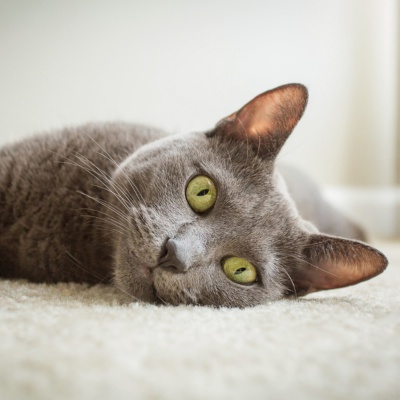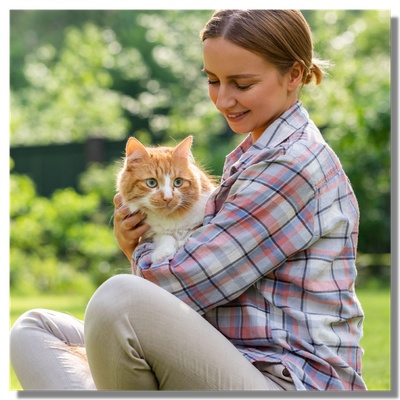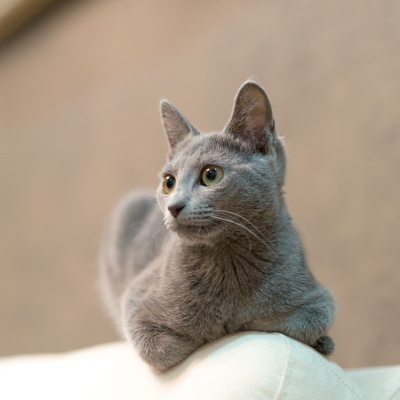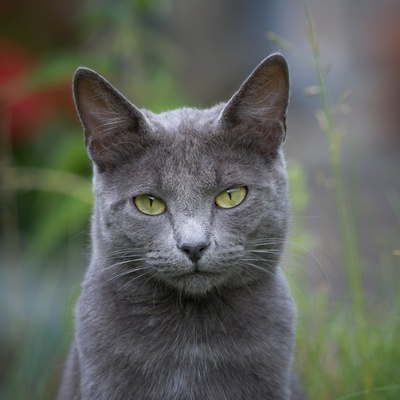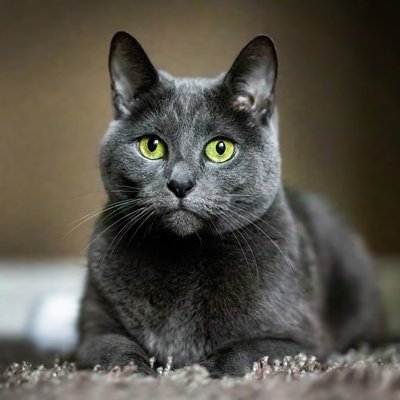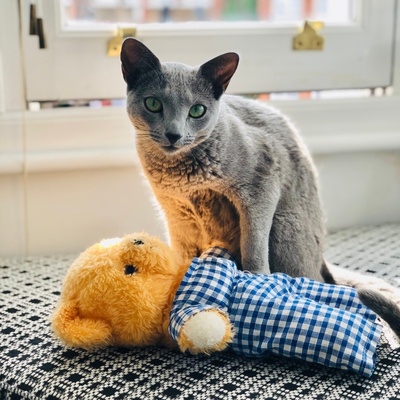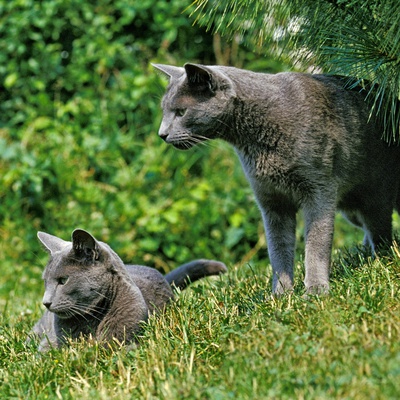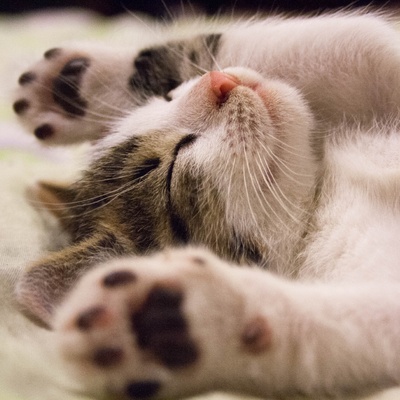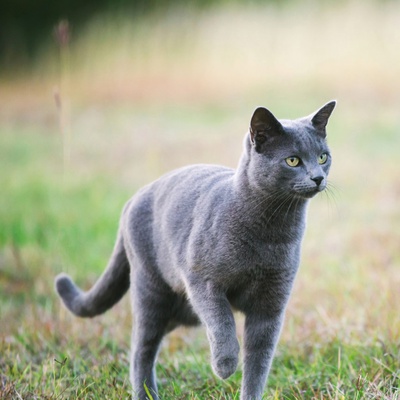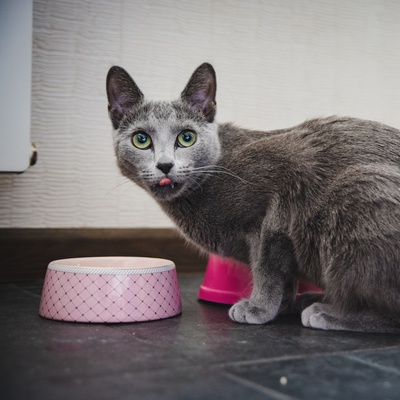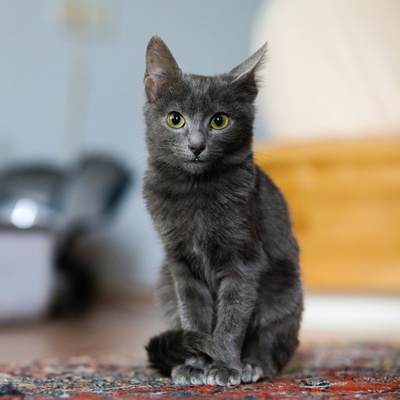Présentation du Bleu Russe
Découvrez tout ce qu’il faut savoir sur le Bleu Russe : ses caractéristiques, son comportement, son éducation, son prix.
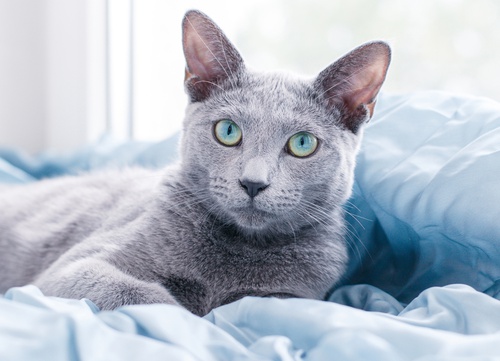
Découvrez tout ce qu’il faut savoir sur le Bleu Russe : ses caractéristiques, son comportement, son éducation, son prix.
Le Bleu Russe est une race de chat d'une élégance incontestable. Originaire du nord de la Russie, cette race tire ses racines de chats sauvages qui vivaient dans les zones climatiques froides de l'Arctique. Cette provenance unique lui a conféré un pelage court, dense et d'une douceur exceptionnelle, de couleur bleu-gris, qui semble presque argenté. Au-delà de son apparence sophistiquée, le Bleu Russe est aussi reconnu pour son caractère affectueux et sa tranquillité.
Il est connu pour être un chat réservé, souvent décrit comme timide avec les étrangers, mais très attaché à sa famille humaine. Le Bleu Russe, avec sa présence apaisante et sa beauté glaciale, fera certainement le bonheur de tout amateur de chats.
Voici un résumé des caractéristiques spécifiques aux chats de la race Bleu Russe.
Le Bleu Russe est un chat de taille moyenne qui mesure généralement entre 24 et 26 cm de hauteur au garrot, avec un poids variant entre 3 et 5 kg.
Le Bleu Russe possède une fourrure courte et très dense, reconnue pour sa douceur et son épaisseur qui lui offrent une excellente protection contre les températures froides.
Le Bleu Russe est souvent considéré comme hypoallergénique, ce qui en fait un choix idéal pour les personnes souffrant d'allergies.
La robe du Bleu Russe est uniformément de couleur bleu-gris. C'est une couleur unique et profonde, parfois presque argentée, qui lui donne son nom et son allure particulière.
Le Bleu Russe est un chat qui s'adapte bien à la vie en intérieur. Il apprécie la tranquillité et la stabilité de son environnement.
Le Bleu Russe est un chat réservé et tranquille. Il peut être timide avec les étrangers, mais une fois en confiance, il est très affectueux et fidèle à sa famille humaine. Il s'entend généralement bien avec les autres animaux.
Le Bleu Russe est généralement un chat robuste et en bonne santé. Cependant, comme toute race, il peut être sujet à certaines conditions génétiques, donc un suivi régulier chez le vétérinaire est recommandé.
Avec son tempérament calme et affectueux, le Bleu Russe est généralement facile à éduquer. Une approche douce et patiente est préférable lors de son éducation, car il est sensible aux changements brusques et aux punitions.
Nous pouvons vous aider !
En effet, chaque chat a son propre caractère et des besoins spécifiques. Faire le bon choix vous permettra d'assurer son bien-être et le vôtre.
Grâce à notre quiz, vous saurez la race qui vous correspond en fonction de votre style et lieu de vie, vos attentes et bien d'autres critères.
N'attendez plus et faites le quiz pour connaître la réponse !
Le Bleu Russe est un chat d'une beauté rare. Sa robe d'un bleu-gris unique et son allure aristocratique lui confèrent une élégance qui ne passe pas inaperçue.
Le Bleu Russe est un chat de taille moyenne, mesurant généralement entre 24 et 26 cm de hauteur. Son corps élancé, soutenu par une ossature fine mais robuste, est souvent qualifié de gracieux. Les mâles, plus massifs que les femelles, pèsent généralement entre 4 et 5 kg, tandis que les femelles pèsent en moyenne entre 3 et 4 kg.
Le Bleu Russe est connu pour sa croissance relativement rapide, atteignant généralement son poids et sa taille définitifs vers l'âge de 2 ans.
Le Bleu Russe arbore un pelage court à mi-long, particulièrement doux et dense. La densité de sa fourrure est due à la présence d'un sous-poil épais qui lui offre une excellente résistance aux variations de température. Sa fourrure a une texture veloutée incomparable qui est souvent comparée à celle d'une peluche de luxe.
La robe du Bleu Russe, comme son nom l'indique, est d'un bleu-gris unique qui peut varier d'un ton clair à un ton plus foncé. Cette couleur est si caractéristique de la race qu'elle a même donné son nom à la race. Tous les Bleus Russes doivent avoir cette couleur de robe, sans aucune tache blanche ou de toute autre couleur.
Bien que non classé comme hypoallergénique, l'entretien régulier peut aider à minimiser les allergènes.
Au-delà de son pelage distinctif, le Bleu Russe a de nombreuses autres caractéristiques qui le rendent unique. De taille moyenne, il arbore un corps musclé et élancé, démontrant une forte ossature sous son pelage dense. Ses pattes sont fines mais robustes, s'achevant par de petites griffes arrondies.
Les oreilles du Bleu Russe sont larges et bien espacées, pointues à leur extrémité et assez grandes par rapport à la taille de sa tête, qui est de forme cunéiforme.
Ses yeux sont une autre caractéristique notable. De grande taille et de forme presque ronde, ils sont d'un vert émeraude brillant qui contraste magnifiquement avec son pelage bleu-gris.
Le Bleu Russe, malgré son pelage dense et élégant, ne nécessite pas un toilettage excessif. Un brossage hebdomadaire est généralement suffisant pour garder son pelage en bonne santé et sans nœuds. Toutefois, pendant les périodes de mue, il est conseillé d'augmenter la fréquence du brossage pour aider à éliminer les poils morts.
Contrairement à certaines autres races de chats, le Bleu Russe n'a généralement pas besoin de bains réguliers. En effet, les chats sont d'excellents auto-toiletteurs et le Bleu Russe ne fait pas exception à cette règle. Cependant, un bain occasionnel avec un shampoing adapté peut être bénéfique, surtout si le chat passe beaucoup de temps à l'extérieur ou si son pelage devient particulièrement sale pour une raison quelconque.
Le Bleu Russe est une race de chat réputée pour sa douceur, sa tranquillité et sa nature quelque peu réservée.
Le Bleu Russe est un chat tranquille, réservé et facile à vivre. Il développe généralement un lien étroit avec son maître et peut suivre celui-ci d'une pièce à l'autre. Il apprécie les moments de calme et de câlins plus que les jeux bruyants et agités.
Il exprime souvent ses sentiments à travers un doux ronronnement et des vocalisations discrètes. Le Bleu Russe a besoin d'un propriétaire qui respecte son besoin de calme et qui est prêt à passer du temps de qualité avec lui.
Connu pour son tempérament calme et doux, le Bleu Russe est généralement patient et tolérant. Il est bien adapté à une variété de foyers, y compris ceux avec des enfants, des chiens et d'autres chats.
Toutefois, lorsque son seuil de tolérance est atteint, le Bleu Russe préfère se retirer dans un endroit tranquille pour se détendre plutôt que d'adopter un comportement agressif. Sa nature calme et réservée fait du Bleu Russe un compagnon idéal pour ceux qui recherchent un chat doux et affectueux.
Le Bleu Russe est une race de chat qui a la capacité de s'adapter à différents environnements, que ce soit un appartement citadin ou une maison de campagne. Cependant, ce chat très sociable et attaché à son maître a besoin d'avoir une présence humaine régulière pour s'épanouir.
Malgré son allure élégante et raffinée, il a besoin d'espace pour explorer et se dépenser. Si vous craignez de perdre sa trace, vous pouvez lui installer un collier GPS qui vous permettra de suivre ses déplacements et de le localiser en cas de fuite.
L'éducation du Bleu Russe doit commencer dès son plus jeune âge pour éviter qu'il ne développe des comportements indésirables. Comme pour toute race de chat, l'éducation doit être basée sur des principes tels que la bienveillance, l'écoute, la récompense et une certaine fermeté.
L'important est d'être cohérent tout au long de son apprentissage pour qu'il enregistre les bons comportements dès le début. L'éducation par le jeu s'avère également très efficace avec cette race. Cela permet de stimuler son intelligence, d'encourager un bon comportement et de renforcer le lien entre le chat et son maître.
Choisir un chat qui vous ressemble, c'est l'assurance d'une vie harmonieuse ensemble.
Le Bleu Russe est un chat calme et réservé, reconnu pour sa robustesse et sa résilience en matière de santé. Cette race de chat ne présente généralement pas de problèmes de santé spécifiques, ce qui en fait un compagnon relativement facile à entretenir sur le plan médical.
Le Bleu Russe est un chat généralement en bonne santé, avec une résistance remarquable aux maladies. Cependant, comme pour toutes les races de chat, il peut être prédisposé à certaines maladies héréditaires spécifiques, telles que la cardiomyopathie hypertrophique féline, qui est une maladie cardiaque, ou la polykystose rénale, qui se caractérise par la formation de kystes dans les reins.
Bien que ces maladies soient rares, un test ADN peut être effectué pour détecter la présence des gènes responsables et prévenir leur transmission. Il est également essentiel d'effectuer des visites régulières chez le vétérinaire pour vacciner le Bleu Russe contre les maladies courantes comme le typhus et la rage, assurant ainsi sa santé et son bien-être sur le long terme.
Le Bleu Russe est un chat de taille moyenne à la musculature fine et athlétique. Pour maintenir sa silhouette élancée et assurer sa santé optimale, il est important de lui fournir une alimentation de qualité. Les croquettes de haute valeur nutritionnelle sont recommandées comme base de son alimentation. Pour compléter son régime, vous pouvez envisager d'ajouter des légumes verts riches en eau à ses croquettes, ce qui aidera également à soutenir le fonctionnement de son système rénal.
Le Bleu Russe est une race qui atteint sa corpulence définitive assez tôt, vers l'âge de 2 ans. Du fait de cette croissance rapide, il est essentiel que son alimentation soit adaptée et contrôlée. Pour assurer une transition alimentaire en douceur, il est recommandé de maintenir la même marque de croquettes tout au long de sa croissance. En outre, l'alimentation doit être donnée à des heures fixes pour éviter toute perturbation du système digestif.
Bien que le Bleu Russe soit un chat plutôt calme qui aime se prélasser à l'intérieur, il est crucial de contrôler son alimentation et de l'encourager à faire de l'exercice régulier pour éviter le surpoids. Un Bleu Russe peut en effet prendre du poids s'il ne bouge pas assez et si son alimentation n'est pas bien contrôlée.
Pour maintenir sa santé et son poids optimal, encouragez votre Bleu Russe à jouer, à courir et à sauter. Interagissez avec lui et proposez-lui des sessions de jeu régulières pour lui offrir une stimulation physique et mentale nécessaire.
Le Bleu Russe est une race très appréciée pour sa beauté mystique et son comportement calme. On trouve plusieurs élevages de cette race en France. Il est important de prendre en compte quelques facteurs avant l'adoption.
Les chats de race comme les Bleus Russes sont généralement élevés chez des éleveurs professionnels ou dans des chatteries. Avant d'adopter votre chat, il est conseillé de vous rendre sur place pour observer ses conditions de vie.
Le LOOF (Livre Officiel des Origines Félines) référence tous les chats de race nés en France. Ainsi, chaque chat de pure race se voit attribuer un numéro à la suite d'une DNS (Déclaration de Saillie et de Naissance). Lorsque vous entamez une procédure d'adoption, il est important de vérifier ce numéro afin de ne pas tomber sur des éleveurs malhonnêtes.
Il est également très important de vérifier que tous les examens de santé et les tests ADN ont été réalisés sur lui et sur ses parents, pour être informé des éventuels problèmes de santé héréditaires.
Le prix d'un Bleu Russe pure race dépend de plusieurs facteurs : le sexe, la lignée, le pedigree, l'âge, la capacité de reproduction, etc. Son prix peut varier de
à
. Il est aussi possible d'adopter un Bleu Russe adulte, le prix est généralement moins élevé, se situant entre
et
. Au-delà du coût à l'achat, un chat a des besoins quotidiens et il est nécessaire de lui prodiguer certains soins tout au long de sa vie. Ces dépenses doivent être prises en compte.
Le Bleu Russe a une espérance de vie située entre 15 et 20 ans en moyenne. C'est un réel engagement et une décision qui demande réflexion. Adopter un Bleu Russe, c'est l'adopter pour la vie !
Choisir un chat qui vous ressemble, c'est l'assurance d'une vie harmonieuse ensemble.
Pour bénéficier des informations les plus adaptées, des bons moyens de paiement et d'une livraison dans votre région, veuillez choisir le site correspondant à votre pays.
